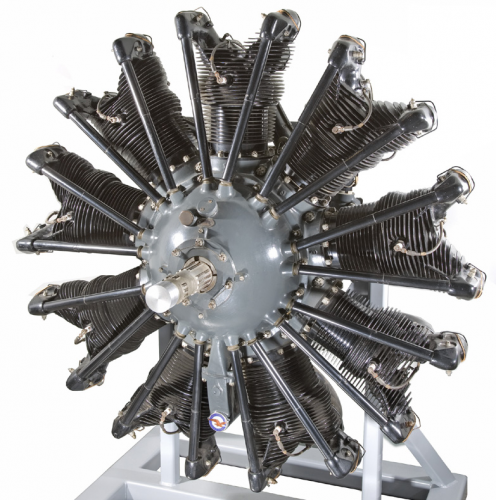Ask the Mechanic - The history of aircraft piston-engine development
The first and most important requirement for an aircraft engine is that it must be reliable. At the end of WWI, the Curtis OX-5 often failed after only 30 hours of operation, but 30 years later, the Wright R-3350s ran for 3,000 hours. Airlines used multiple engines, kept good records and overhauled them before they failed.
Secondly, aircraft engines must produce as much power as possible while weighing as little as possible. A more powerful engine is bigger, but also heavier. Making it lighter means it may become less reliable. The 90 hp OX-5, weighed 4.33 lb for every hp produced; the 250 hp Bentley rotary, 1.96 lb/hp. The very successful Pratt & Whitney Wasp had a ratio of 1.55 lb/hp, while the ultimate radial, the Wright R-3350, was 0.99 lb/hp.

The Pratt & Whitney R-1340 radial engine
Finally, an aircraft engine must be fuel efficient. A great deal of the take-off weight of an airplane is dedicated to fuel. If the engine is more fuel efficient, then less fuel must be carried to go the same distance and more passengers can be carried. Tens of thousands of pounds of fuel were carried in the huge transports of the 1950s, and improvements in fuel consumption made significant differences in overall aircraft capability.
Improvements included improving engine design and construction; the development of streamlined engine cowls that reduced the drag of radial engines; and the introduction of the constant speed propeller.
Engine arrangement may be the in-line engine, or the radial engine. An engine will flex as it runs and must be stiff enough so that it does not crack its components. This requires a very heavy crankcase and crankshaft. The radial configuration avoids this problem by having a short, stiff crankcase and crankshaft. While engines are able to achieve higher power by turning at a higher RPM, the propeller RPM is limited by tip speed. The answer is reduction gearing, allowing the propeller to turn slower than the engine.
An engine designer typically makes everything out of the lightest material that is practical. This means using aluminum for the bulky components (such as pistons, cylinder heads, and crankcases) and steel for the highly stressed components (such as crankshafts, connecting rods, and gears). The designer could choose either liquid cooling, where the cylinders are surrounded by a liquid coolant that is circulated to a radiator where it gives up this heat to the air, or air-cooling where cooling fins on the cylinders give up their heat directly to the air. Another improvement was supercharging – where additional power can be achieved by forcing the fuel-air mixture into the engine at higher pressure.
Early engines were lubricated with castor oil. This was chosen because it had nearly constant viscosity across its temperature range. The introduction of high-quality mineral oils allowed greater power to be produced. Of at least equal importance was the development of fuels. It was discovered that pure iso-octane improved engine performance. In the late 1920s, the addition of tetraethyl lead to gasoline drastically improved its octane rating.
The final area of improvement was the actual operation of the engine. When the R-3350 entered service, it often did not run more than 100 hours before having to be overhauled. In airline service, it would sometimes last over 3,000 hours. The early engines were run very hard and very hot, often overheated, flown by inexperienced crews, and maintained by poorly trained mechanics. In airline service, engines were treated very well, kept cool and flown and maintained by experienced crew.
By 1955, aircraft piston engines had reached their pinnacle of development. They had become light, powerful, reliable, and fuel-efficient. But they had also reached their pinnacle of complexity and power. Around 1945, engineering effort at the major engine plants turned away from piston engines to jet engines.